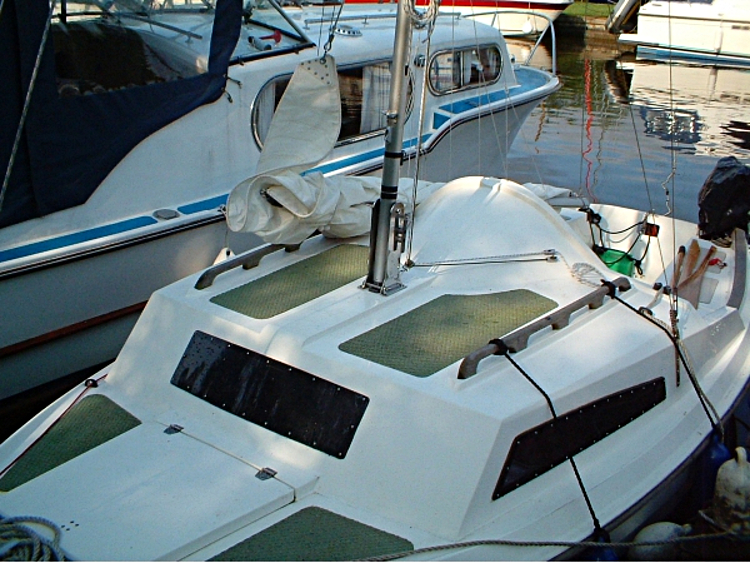Page updated: 9 November 2011
 Steelwork
Steelwork
Apart from the essential rigging components, steelwork on a SeaHawk was limited to the optional extras of a pulpit and cockpit guard rails. During Reedcraft and Moore's manufacture few customers failed to buy either of these options. It is interesting to note that the last known Moore's SeaHawk, #412, had neither pulpit or nor guard rails, but instead had only the wooden capping to the cockpit combing found on Pyecraft boats.
Although variations in pulpits are found, it appears that the type in the photograph below is the standard version. Its main features being a single post in the bows and fairlead for the anchor chain. As they were essentially hand made, slight variations are seen, notably in the side arms bend down to the decks. In some cases are a noticeable angled turn rather than the more typical gentle curve seen in the example below. In contrast, none of the handful of boats built after Moore ceased production has a pulpit.

Cockpit guard rails also vary though in minor ways. Early boats tend to be fitted with the slightly lower rails seen in the photograph below, on #232, the last boat known to be fitted with this type. Note how the rail is swept into the trailing edge of the of the cabin side extension.

The second most popular type, fitted by Reedcraft is shown next. This rail is set slightly higher. This version normally incorporates thimbles welded into the swept uprights. On later Moore's built boats the thimbles were often replaced by an angled rod that formed a similar loop.

On some boats the guard rails are built still higher. On others they are replaced by a full pushpit which wraps around the transom but does not run the full length of the cockpit sides. It must be assumed that all these variations were built to the original customers order, or fitted later by second owners.
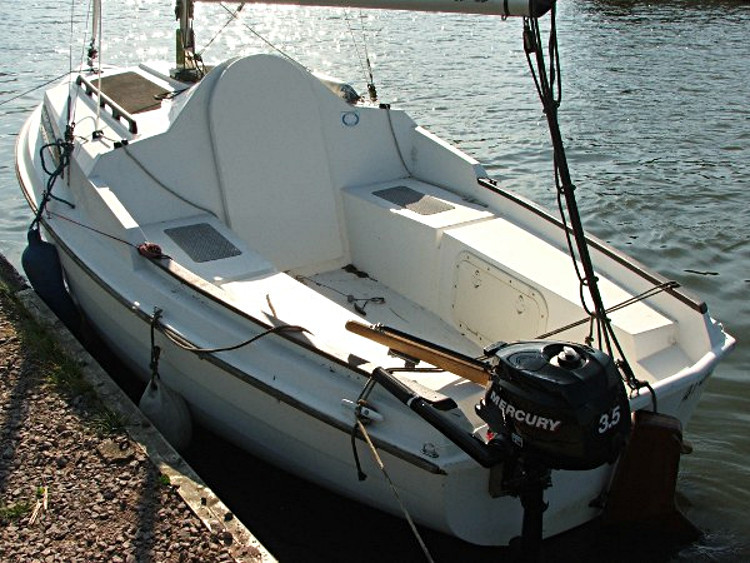
As noted above, none of the Pyecraft boats have guard rails. Instead they are all fitted with a wooden capping that overhangs the cockpit combing.
 Cabin Door
Cabin Door
The cabin door is another highly variable feature. Most boats seem to have a the two piece door seen here, usually sporting a handle only on the upper section. On Reedcraft boats, the weatherstrip at the junction of the two parts was constructed of resin. Many boats are seen with a variety of types of wooden weatherstrip. This would suggest that either Moore's approach was different or many single piece doors have been converted by owners. This last possibility may also account for the slight variation in the size of the two parts that are seen.

Normally, the bottom of the door is supported on a wooden threshold strip, as seen above. The length of this threshold varies with each boat and some seem to have dispensed with the threshold strip all together.

Above is a typical single piece door, again with just a single handle. The only trouble with a single piece door is that there is no obvious place for it to be stowed while sailing, but some owners prefer it as it must provide some limited additional security.
 Cockpit Lockers
Cockpit Lockers
Cockpit lockers appear to have been considered an optional extra from the start of Reedcraft's manufacture. Certainly, the Moore's 1986 price list was showing "Cockpit Lockers" priced individually. The 1991 price list replaces that item with "Cockpit Lockers c/w lids", but they were still priced "each" and not as a pair.
Further evidence is the existence of boats without lockers, as seen in the photograph of "Bluebird", below. Other evidence is that some boats have radically different lockers from the typical ones described below, suggesting that they may have been fitted later by owners, or in response to a customers special order. Notable amongst these is that seen on SeaHawk, which is understood to have been Moore's exhibit at the London Boat Show in 1992.

Typically, the lockers on a Reedcraft boat are simple flanged bins constructed of GRP. They are fitted into a roughly rectangular aperture cut into the side of the cockpit and are secured by a varying number of self-tapping screws. The bins increase in height slightly towards the stern as the base follows the line of the cockpit floor which drops towards the transom.
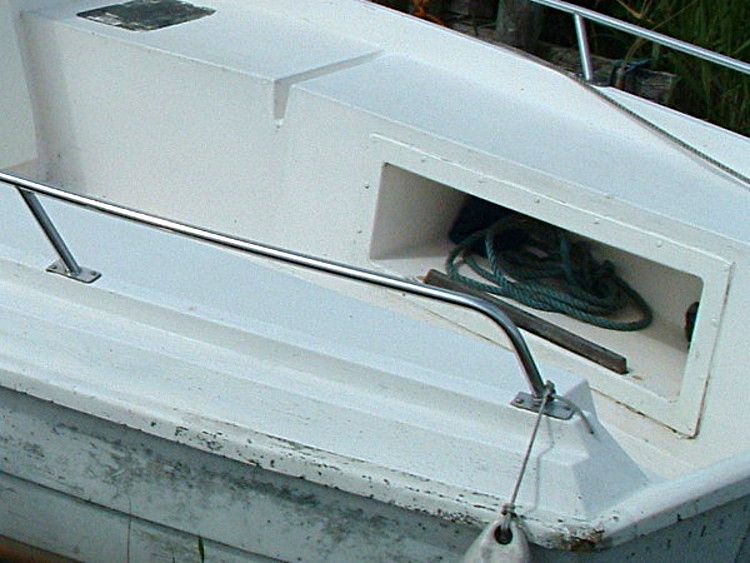
Even in the two-berth boat the dimensions of the bins vary slightly from boat to boat. In addition, two cases are known where the cockpit moulding has a recessed lip to the aperture that allows for the locker bins to fit flush rather than be the normal surface mount seen in the examples here. Normally, the lockers were supplied with a simple wooden threshold strip and no lid. In one case, it is known that the starboard locker was supplied with a bottom hinged lid and the stern wall cut away to allow room for a 4hp engine to be stored there, so it is likely other modifications were incorporated at the customer's request.
Four-berth Reedcraft boats had significantly shorter lockers and these were also set further aft. This was to allow for the extra length under the cockpit needed for the extended quarter-berths. However, the construction and method of fitting remained the same.
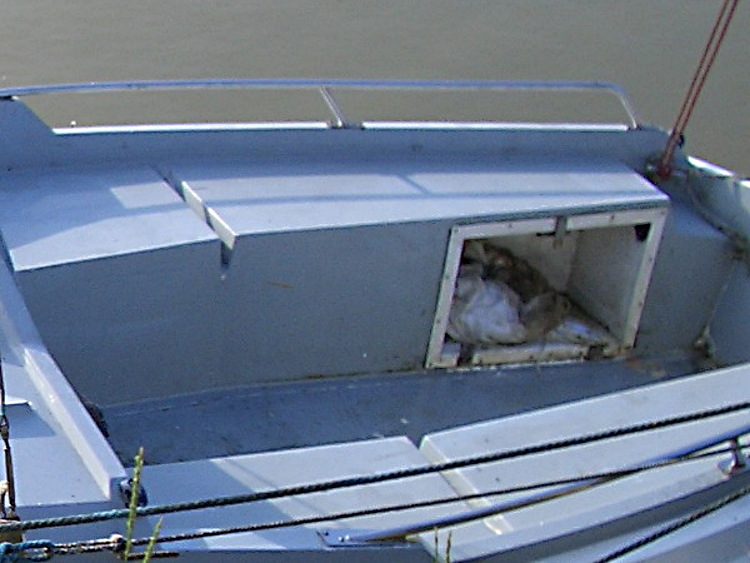
Most Moore's boats have a radially different design of locker. Instead of being fitted after the the hull and superstructure are joined, They are attached to the underside of the superstructure moulding before it is joined to the hull. This design provides a significant lip to the opening that helps keep the contents inside, but it does require a drain hole that needs to be kept free of muck, or the locker fills with rain or spray.
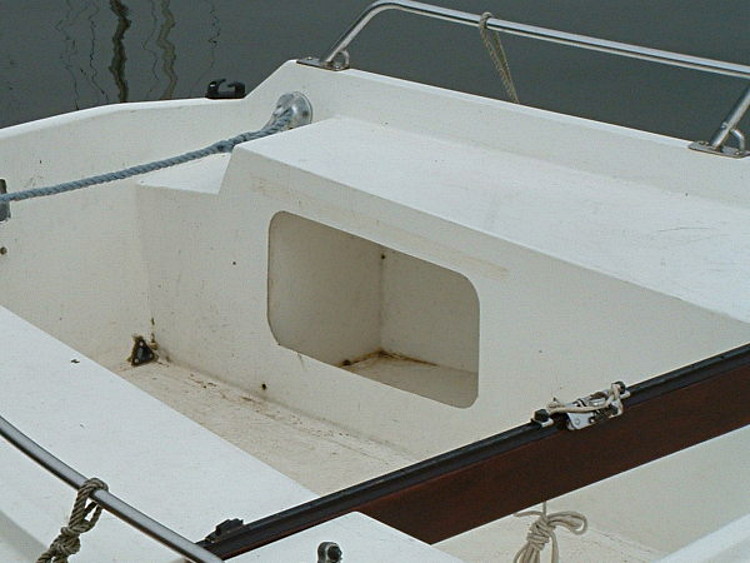
 Other Topside Variations
Other Topside Variations
The last known Moores boat, SeaHawk
#412, does not have the "standard" Moore's lockers. Instead
she has commercially available plastic locker lids. Interestingly,
the boat looks remarkably similar to the later Pyecraft boats, seen
below. They have the same wooden capping to the cockpit combing and
similar cabin-top handrails and non-slip decking areas.

Externally, the only obvious differences between the late Moore's boat and those from Pyecraft are that the later boats lack framing to the cabin windows and they have externally mounted aft mooring cleats and larger cockpit lockers.
